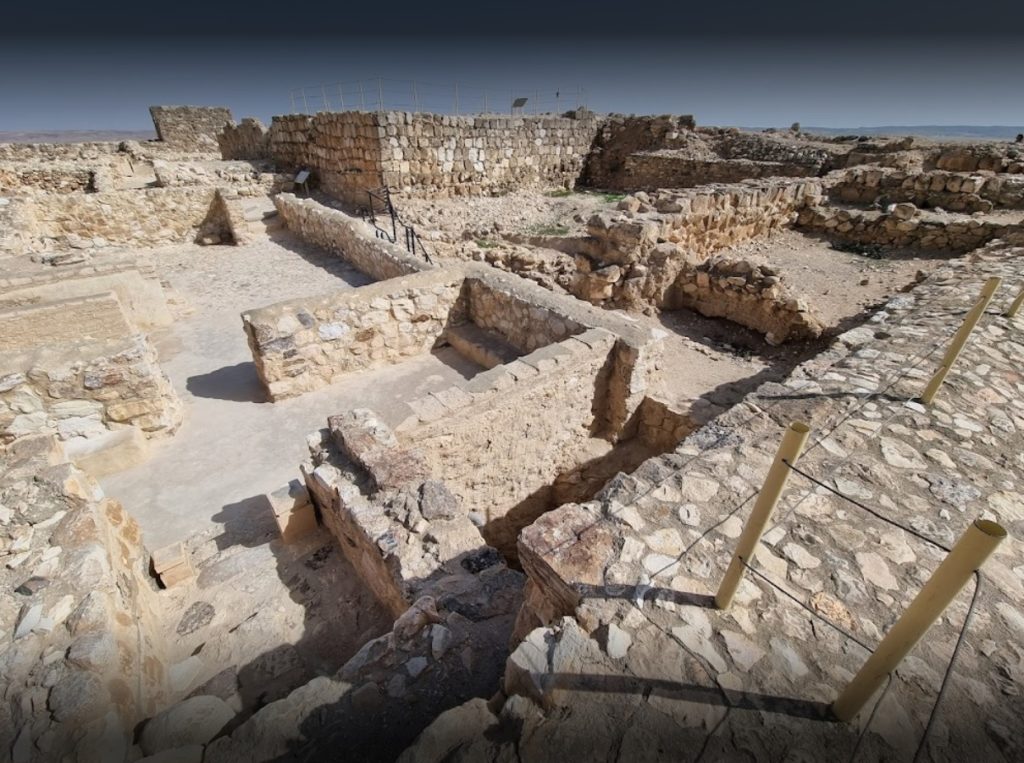
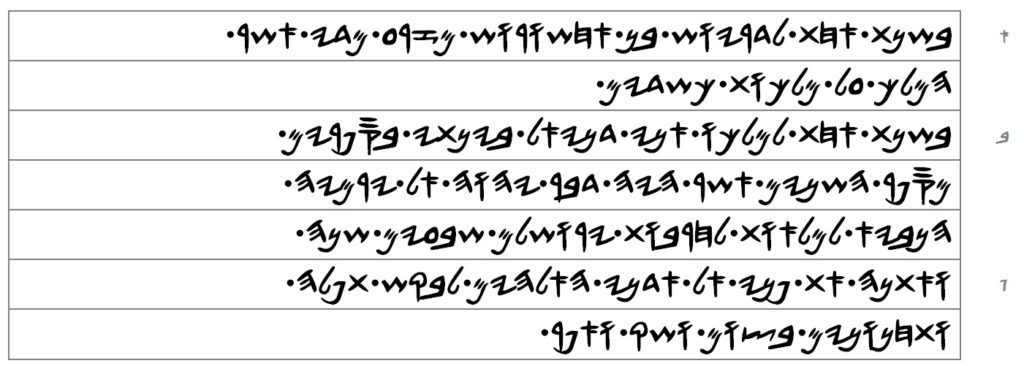
[1] In the first year of Daray’osh, son of Akhashorosh, from the seed of the Maday, which he was caused to be king upon the kingdom of the Chashdaym.
[2] In the first year of his reign, I Danay’al understood by books the number of the years, which was the word of YA’OH unto Yaram-Ya’oh the prophet, to fulfill for the desolations of Yaroshalam: seventy years.
[3] And I gave my face unto my Master, the Higher Power, to seek in prayer, and supplications, by fasting, and sackcloth, and ashes.
COMMENTARY OF DANAY’AL 9:1-3
[1] Daray’osh the Maday (Darius the Mede), the son of Akhashorosh (Cyaxeres II), was hamlach (’caused to be made king’) of the Chashdaym (Babylonians). The passive of the causative verb, hamlach (המלך), implies that Daray’osh was appointed king of Babylonia by someone who outranked him in terms of authority, and that someone was Cyrus the Great (547-517 BCE) who conquered the Maday in 550 BCE. Cyrus dethroned his maternal grandfather Astyages (Ishtumegu) at the Maday capital of Ecbatana in 550 BCE, but Cyrus did not eliminate the monarchy of the Maday and become their king. He allowed his maternal uncle, a much younger sibling of Astyages who had the same name as their father Cyaxeres I, and who was raised as a “son” of Astyages, to become king of the Maday from 550 BCE to his death in 518 BCE.
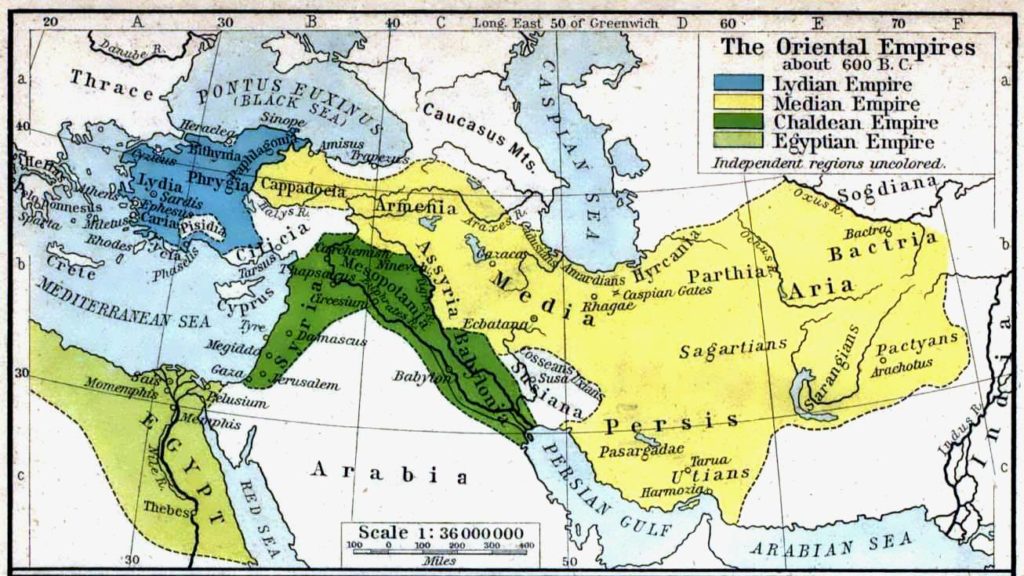
The 5th century Greek historian, Herodotus, the father of lies, was misinformed in his biased romance account of the Maday which is full of inaccuracies. All of the Greek accounts are confused because they were written centuries after the fact by foreigners. The new king of the Maday in 550 BCE was subservient to Cyrus, and this fulfilled the prophecy of the ram with two horns in Danay’al 8:3 where the higher of the two horns came up last. The Maday were once the overlords of the Persians, but when Cyrus removed his grandfather as king of the Maday in 550 BCE the Persians became the overlords of the Maday. The Persians are the second horn on the ram in the vision who came up last and became higher than the first horn.
Cyrus captured Babylon peacefully in 539 BCE but he abdicated the throne of Babylon nine years later. He returned to Persia in 530 BCE and entrusted the kingdom of Babylonia to his relative Daray’osh who reigned at Babylon for ten years, from 530 BCE to 520 BCE. The 9th chapter of the Book of Danay’al was written in the year 529 BCE, the first official year of Daray’osh the Maday as “king of Babylon”.
[2] Danay’al had been studying the books of scripture, and the book of the prophet Yaram-Ya’oh (Jeremiah) in particular. He realized that the seventy years for the desolations of Yaroshalam (Jerusalem) spoken of by Yaram-Ya’oh in Yaram-Ya’oh 25:11-12 were reaching their conclusion.
THE KEY THAT UNLOCKS THE MEANING OF THE 70 WEEKS PROPHECY TOWARDS THE END OF THIS CHAPTER IS UNDERSTANDING THE CORRECT STARTING AND ENDING YEARS OF THE SEVENTY YEARS FOR THE DESOLATIONS OF YAROSHALAM SPOKEN OF BY YARAM-YA’OH (JEREMIAH) 25:11-12.
The desolations of Yaroshalam began in 589/8 BCE when the Neo-Babylonian army of Nabochadnezzar II (605-562 BCE) laid siege to the city and began to rampage it. The exact date was 10.10.4641, i.e. the 10th day of the 10th month in the 9th year of King Tsadak-Ya’oh (Zedekiah) according to 2 Kings 25:1; Yaram-Ya’oh (Jeremiah) 39:1; 52:4; and Ya’oh-khazak-al (Ezekiel) 24:1-2. This converts to Friday, Jan 14, 588 BCE in the pagan Julian calendar. The calendar year began in the spring of the year 4641 (i.e. 589 BCE) and the desolations of Yaroshalam commenced in the winter of that same year in 588 BCE. Hence, the seventy years began with the year 4641 and ended seventy years later in the year 4711 (i.e. 519 BCE). Danay’al wrote the 9th chapter of his book ten years prior, in the year 4701 (i.e. 529 BCE).
The prophet Yaram-Ya’oh commenced the seventy years of desolations of Yaroshalam with the rampaging siege of the city by Nabochadnezzar II in 589/8 BCE, as we have just seen. However, the modern reconstruction of ancient history made by European scholars would have you believe that the seventy years concluded with the first year of Cyrus as king of Babylon in 538 BCE. That is a period of fifty-one years, not seventy years! 2 Chronicles 36:21-23 makes it clear that the first year of Cyrus must be the seventieth year of the city of Yaroshalam’s desolations. Therefore, 538 BCE is not the seventieth year and not the “first year” of Cyrus that 2 Chronicles 36:22 and Ghazar’a 1:11 are talking about. These scriptures are talking about the second throne tenure of Cyrus in Babylon which commenced in 520 BCE, making 519 BCE the first year of his SECOND term as king of Babylon and the seventieth year since the desolations of Yaroshalam commenced.
[3] Danay’al writing the 9th chapter in 529 BCE realized that there were only ten years left for the desolations, and so he began to seek the face of YA’OH and to pray and to fast for his people, and for the holy city of Yaroshalam.
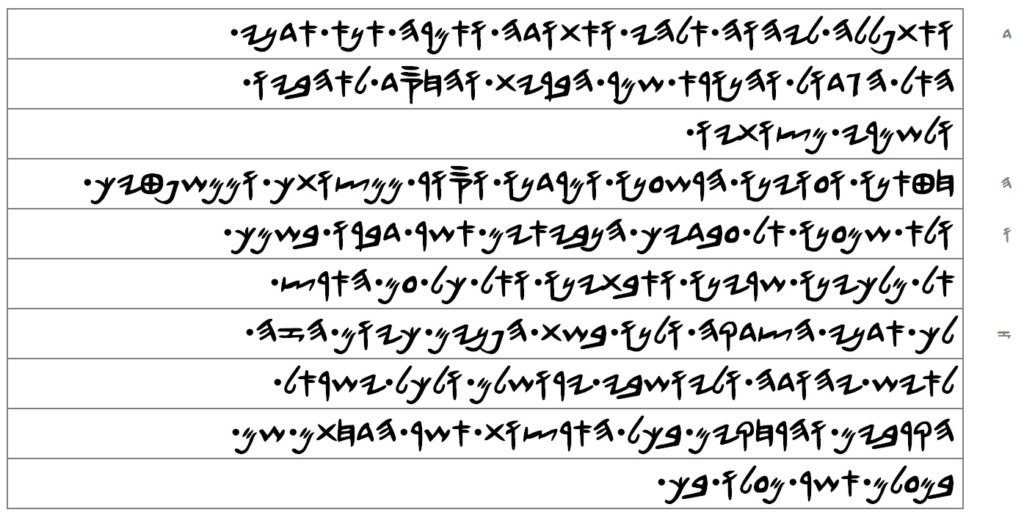
[4] And I prayed unto YA’OH, my Higher Power, and that I would give thanks, and that I would say: I beg, Lord, the great Higher Power, the one who terrifies, the one who keeps the covenant and the mercy to those who love Him, and to those who keep His commandments.
[5] We have sinned, and we have committed iniquity, we have done wickedly, and we have rebelled, and departed from your commandments, and from your judgments;
[6] and not have we listened to your servants the prophets which spoke in your name to our kings, our princes, and our fathers, and to all the of the land.
[7] To you, Lord, belongs righteousness, and to us shame of the face, as it is this day; to each man of Ya’ohdah and to the inhabitants of Yaroshalam, and to all Ya’oh-shar-al, the ones near, and the ones far away in all the lands which you have driven them there because of their trespass which they have trespassed against you.
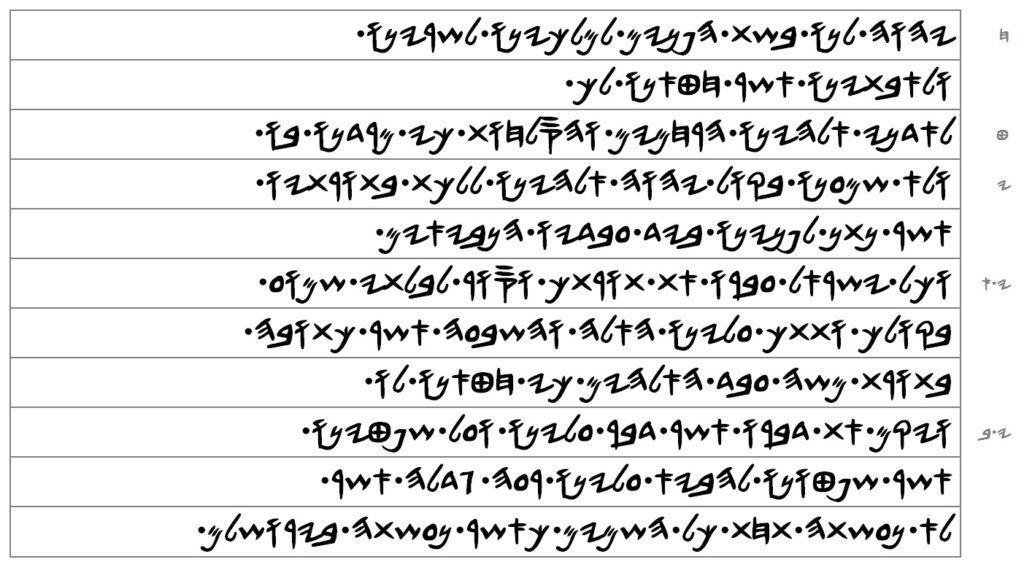
[8] YA’OH, to us is shame of the face, to our kings, to our princes, and to our fathers which have sinned against you.
[9] To you Lord, our Higher Power, belong the mercies, and the pardonings, for we have rebelled against Him.
[10] And not have we listened to the voice of YA’OH our Higher Power, to walk in His instructions which He gave before us by the hand of His servants the prophets.
[11] And all Ya’oh-shar-al have transgressed your Thorah, and departed that they will not obey in your voice; and your poured out upon us the curse, and the oath which is written in the Thorah of Mashah, the servant of the Higher Power, for we have sinned against Him.
[12] And He confirmed His word which He spoke against us and against our judges who judged us, to bring upon us great evil which not has been done beneath all the heavens, like as that which has been done in Yaroshalam.
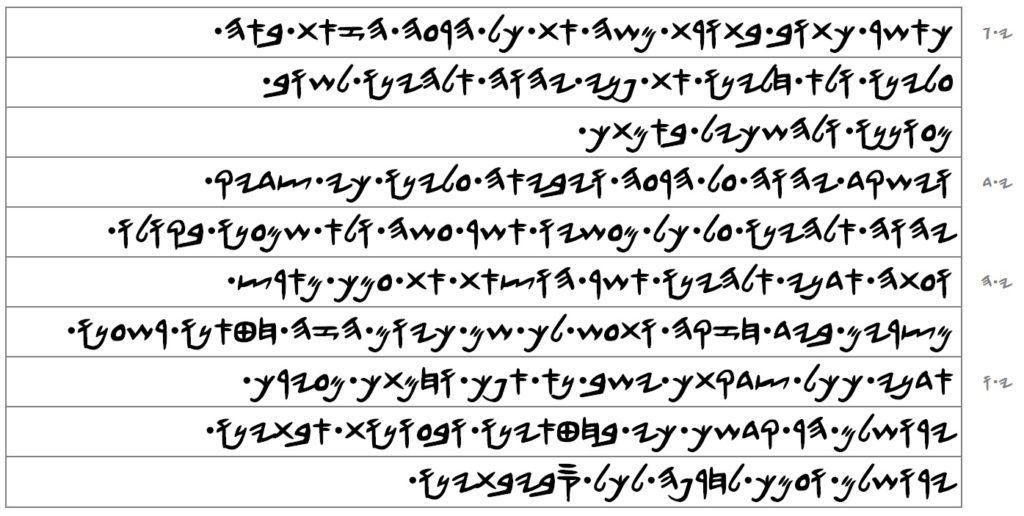
[13] As it is written in the Thorah of Mashah is all this evil come upon us, and not have we become weak to the face of YA’OH, our Higher Power, to return from our iniquities, and to comprehend your truth.
[14] And YA’OH watched upon the evil, and He brought it upon us; because righteous is YA’OH, our Higher Power, upon all His works which He does, and not have we listened to His voice.
[15] And now Lord, our Higher Power, which brought your nation from the land of Matsraym by a strong hand, and has made for You a name, like it is this day; we have sinned, we have done wickedly.
[16] Lord, according to all of your righteousness, let it return please, your anger and your wrath, from your city Yaroshalam, your set apart mountain; for because of our sins and because of the iniquities of our fathers, Yaroshalam and your people are for a reproach to all that surround us.
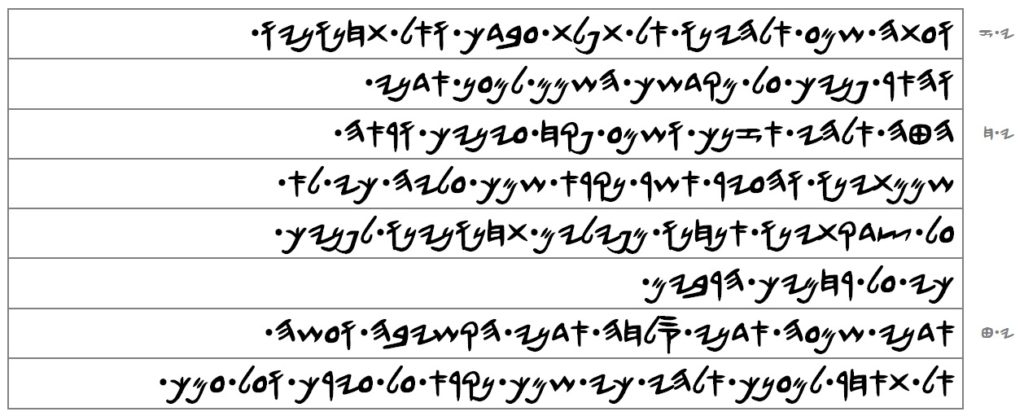
[17] And now, listen, our Higher Power, to the prayer of your servant, and to his supplications; and shine your face upon your tabernacle, the one that is desolate, for the sake of my Lord.
[18] Bend down, my Higher Power, your ear and hear! Open your eyes and see our desolations and the city which is called your name upon it! For not because of our righteousness are we the ones causing to fall our supplications before you; but because your great mercies.
[19] My Lord, hear! My Lord, forgive! My Lord, pay attention! And do not delay for your own sake My Higher Power, for your name is called upon your city, and upon your people!
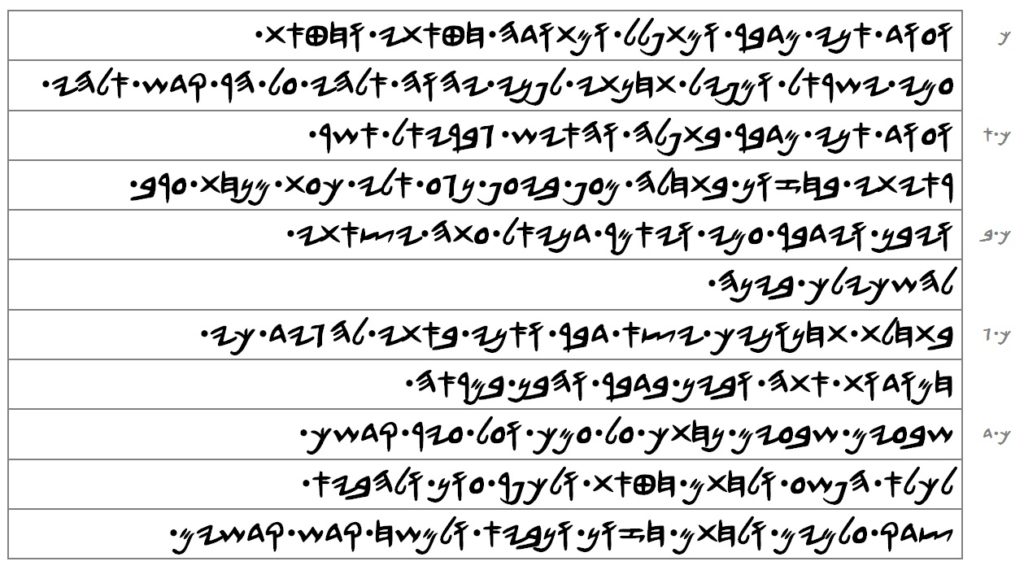
[20] And while I am speaking and praying and giving confession of my sins and the sins of my nation Ya’oh-shar-al, and falling my supplications before YA’OH, my Higher Power, about the set apart mountain of my Higher Power.
[21] And while I am speaking in prayer the man Gabaray’al, which I had seen in the vision at the first, is the one caused to fly in fatigue, the one touching me at the time of the evening offering.
[22] And he instructed, and he spoke with me, and he said: Danay’al, now I have come forth to make you intelligent of understanding.
[23] At the beginning of your supplications, it came forth the word, and I came to declare, for desires are you: and understand in the word, and cause to consider in the vision.
[24] Seventy weeks have been determined upon your nation, and upon your set apart city, to finish the transgression, and to seal sin, and to cover iniquity, and to bring righteousness everlasting, and to seal vision and prophecy, and to anoint the holy of holies.
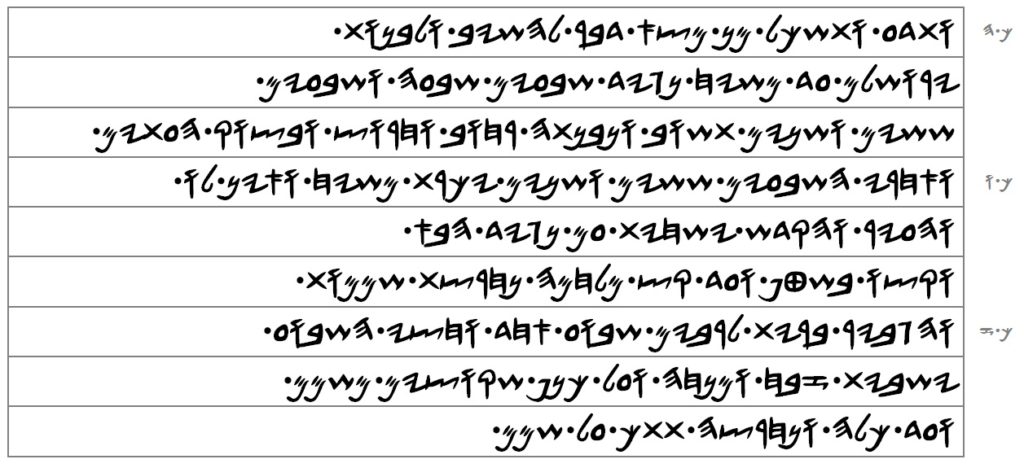
[25] And you will know, and you will comprehend, from the going forth of the word to restore and to build Yaroshalam unto mashaykh, a ruler, is seven weeks and sixty-two weeks. You will return and it will be built square, and be fortified, and troubled are the times.
[26] And after the weeks sixty-two will he be cut off, the mashaykh, and it is not to him; and the city and the temple will be destroyed by a ruler coming, and the end of it is by an inundation, and unto the end war has been determined, desolations.
[27] And he will to make strong a covenant with many one week, and in the middle of the week will he cause to cease the sacrifice and the offering, and upon the wing the abominations of desolations, even until the end, and that which is determined will be poured upon the one who desolates.
COMMENTARY OF DANAY’AL 9:24-27
[24] The word shaboai (‘week’) refers either to a unit of seven consecutive days (cf. Danay’al 10:3) or to a unit of seven consecutive years (cf. Thorah 1.29:27-28). The phrase shAbai’aym shabai’aym (‘weeks seventy’) in verse 24 must mean weeks of years and not days by reason of the simple fact that the six things Gabaray’al says will happen within the given span of time have not been concluded and years have already elapsed since the starting point of the time-span.
The nation of Ya’oh-shar-al and the city of Yaroshalam are given seventy weeks in which to finish the transgression, and to seal sin, and to cover iniquity, and to bring righteousness everlasting, and to seal vision and prophecy, and to anoint the holy of holies. But since it is clear that transgression is still ongoing, iniquity is still ongoing, that everlasting righteousness is still not brought, that vision and prophecy are still not sealed as there are many visions and prophecies awaiting fulfillment, and that the holy of holies has not been anointed and cannot be until a new temple is physically built in Yaroshalam, these six things listed by Gabaray’al which have not happened yet must mean the seventy weeks span years and not days. The seventy weeks of years also cannot be seventy consecutive weeks in a row, i.e. they are not 70 x 7 = 490 uninterrupted years.
[25] The starting point for the seventy weeks is the going forth of the word to restore and build Yaroshalam. The messenger Gabaray’al was speaking to Danay’al in 529 BCE, the first year of Daray’osh the Maday as king of Babylon. The city of Yaroshalam was still a ruin and a desolation at that time. The word to restore and build Yaroshalam was NOT issued by Cyrus the Great ten years later in 519 BCE, the first year of his second tenure as king of Babylon (520-517 BCE). Cyrus of Persia did not order a city to be built, and he did not build a city (Yashai-Ya’oh. 45:13). He ordered a second temple to be built, but he did not enforce his decree. He changed his mind and decided to listen to the counsellors hired by the opposition who stopped the building of the second temple the entire time he was alive (Ghazar’a [Ezra] 4:5). Thus, the order came from YA’OH and 519 BCE is the starting point. Despite what heathen Christians say in their lust to try and prove that their idol Jesus Christ is Almighty God come in the flesh to die for the sins of all humanity the decree of Artaxerxes I (465-424 BCE) allowing Nakham-Ya’oh (Nehemiah) to restore the wall of Yaroshalam rebuilt during Zarababal’s watch is not the starting point of the seventy weeks, nor is it the starting point of any other prophetic time span given by the prophets of YA’OH.
The 70 weeks time-span is broken up into three parts: 7 weeks (49 years) + 62 weeks (434 years) + 1 week (7 years).
The first part covers the 49-year period from 519 BCE to 470 BCE: from the going forth of the word to restore and to build Yaroshalam unto mashaykh, a ruler, is seven weeks. The mashaykh (anointed one) ruling over the nation of Ya’oh-shar-al at the start of this period was Zarababal, the governor of Ya’ohdah, son of Sha’althay’al (Shealtiel). Zarababal was of royal blood, a direct descendant of King Doayd (David), and he was the man who brought back the first colony of our people to the land after the Babylonian captivity (Ghazar’a [Ezra] 2:2; 3:2, 8; Khag-Ya’oh [Haggai] 1:1).
The city of Yaroshalam was completely restored during these 49 years and Zarababal evidently died at the end of these years in 470 BCE. The phrase ghad mashaykh nagayd (‘unto mashaykh, a ruler’) does not mean unto the coming or arrival of a nagayd (‘ruler’), a man with political or military authority, but unto the exit and departure of such a figure. If someone questions how Zarababal was a mashaykh (‘anointed one’) when there is no statement in scripture that a prophet poured oil on his head to anoint him, or because he was not a priest from the tribe of Loay (Levi), you should instruct them that a man who is Ya’oh-shar-al by blood can be a mashaykh without his head being anointed with oil, and without being a priest, according to Yashai-Ya’oh (Isaiah) 45:1. There were leaders of our people other than Zarababal who stood up after the Babylonian captivity, such as Shashbazar (Ghazar’a [Ezra] 1:11; 5:16), Ya’ohshai the high priest (Ghazar’a [Ezra] 2:2; 3:2), Ghazar’a (Ezra), and Nakham-Ya’oh (Nehemiah), but Zarababal was the most significant, for he led the first wave of exiles back to the land and he become the “signet” of YA’OH (Khag-Ya’oh [Haggai] 2:23), thus reversing the curse of his royal ancestor King Yachan-Ya’oh (Jeconiah) who was the “signet” that YA’OH removed from His hand in disgust and disapproval (Yaram-Ya’oh [Jeremiah] 22:24).
The second part covers the 434-year period from 470 BCE to 36 BCE: and sixty-two weeks. During these 434 years the city of Yaroshalam was expanded and the temple mount became square and heavily fortified, but these were “troubled times.” The period ended in 36 BCE when the city was captured by a heathen Adomay (Edomite) named Herod the Great (36-3 BCE). This was the end of the world, so to speak, because the city would never again be ruled by the people of Ya’oh-shar-al descent. The conquest of Pompey 27 years earlier in 63 BCE did not terminate Ya’oh-shar-alay control of the city, but the conquest of Herod did. The Adomay (Edomite) dynasty founded by Herod would remain in control the city from 36 BCE down to 65 CE when Herod Agrippa II was kicked out of the city by our people just before the great war with Rome began in 66 CE. The revolutionaries who took control of the city during the great war were divided against one another in a civil war and the Romans capitalized on this division and succeeded to utterly destroy all of them and the city in 70 CE.
[26] And after the weeks sixty-two will he be cut off, the mashaykh, and it is not to him. In verse 26 we learn that after the sixty-two weeks, i.e. sometime AFTER 36 BCE, a mashaykh (‘anointed one’) will be cut off. This is not the same man who is the nagayd (‘ruler’) in verse 25. The word nagayd in scripture always denotes a man with political and/or military authority. The mashaykh in verse 26 is not called a nagayd and this detail is significant. He does not have the political and/or military authority of a nagayd, but he apparently has power over death because being cut off and killed is wa-ayn lo (‘and it is not to him’). In other words, there is no death to him. The man is put to death but he does not stay dead. He comes back to life. The phrase does not mean he will be left with nothing when he is killed. Literally the words mean, and it is not/nothing to him, with reference to his death just mentioned, and the ‘it’ being supplied by the context. If we agree with heathen translations, ‘and shall have nothing,’ then what it is that he loses is indefinite and unknown, and the reader is left guessing that perhaps he has no more people, or no more name, or that his office of being anointed amongst his people is lost, or that he has lost a home, or family, or he has no child to be his heir and successor. All of this guessing will be the fault of the heathen translation, which is incorrect, and not the text itself when it is read literally. The Christianized rendering of the 1611 Queen James Virus, ‘but not for himself,’ is an utterly impossible one: the substantive ayn (אין) is not a synonym of the negative particle la (לא), but includes a substantive, or verb, or pronominal suffix (cf. Ghamos [Amos] 3:5, ומוקש אין לה).
and the city and the temple will be destroyed by a ruler coming. The death of the mashaykh in verse 26 is subsequently followed by the coming of a nagayd (‘ruler’) who brings about the total destruction of the city of Yaroshalam and the temple, which we know both happened in 70 CE, and we know the ruler responsible was Titus of Rome, the eldest son of Titus Flavius Vespasianus, commonly known as Vespasian.
Therefore, the mashaykh of verse 26 is a man who comes on the scene and is killed sometime between the years 36 BCE and 70 CE. This small window of time does indeed point to the man who the world is now erroneously calling Jesus Christ, but it must be emphasized here that the Greek New Testament is not a reliable account of his words and deeds. The heathen authors of the Greek New Testament have grossly misrepresented our brother and have turned him into a pagan idol god-man whose death atoned for sins. This “Jesus Christ,” the one that the whole world has been told about, is the antichrist, an abomination of desolation, and a myth. The real man behind the pagan myth was a righteous man, a direct patrilineal descendant of Zarababal, who upheld the Thorah of YA’OH and taught his people to keep and to obey all of it, every word. The Greek New Testament, on the other hand, is satanic, an adversary of the Thorah, teaching you to discard certain laws of Thorah as antiquated and imperfect, and to not keep and obey all of Thorah.
and the end of it is by an inundation, and unto the end war has been determined, desolations. According to this, the destruction of Yaroshalam is to be a complete overthrow, a disaster it would never begin to recover from until a specific point in time. The city would remain a ruined desolation “unto the end”. It now becomes obvious that the end of the 62nd week in 36 BCE was also the point when the suspension of the weeks was put into effect. The killing of the mashaykh and the destruction of the city of Yaroshalam and the temple, followed by a period wherein the city remains desolate, all belong to a period AFTER the 62nd week and between the 62nd week and the final 1 week. The first year of the 70th week was NOT 35 BCE. It did not follow immediately after the conclusion of the 62nd week. The first year of the final 70th week is postponed and as of this year 7251 (i.e. 2022) the GAP has lasted 2,057 years exactly.
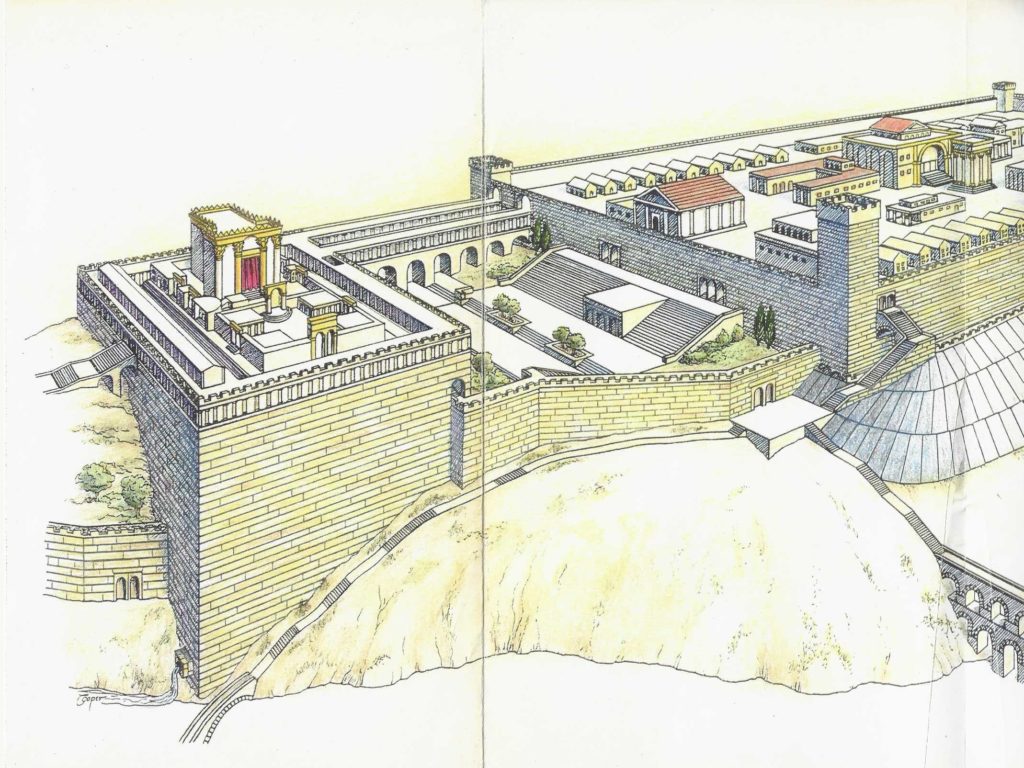
The site is now erroneously called Tel Arad because the heathens have been confounded by YA’OH.
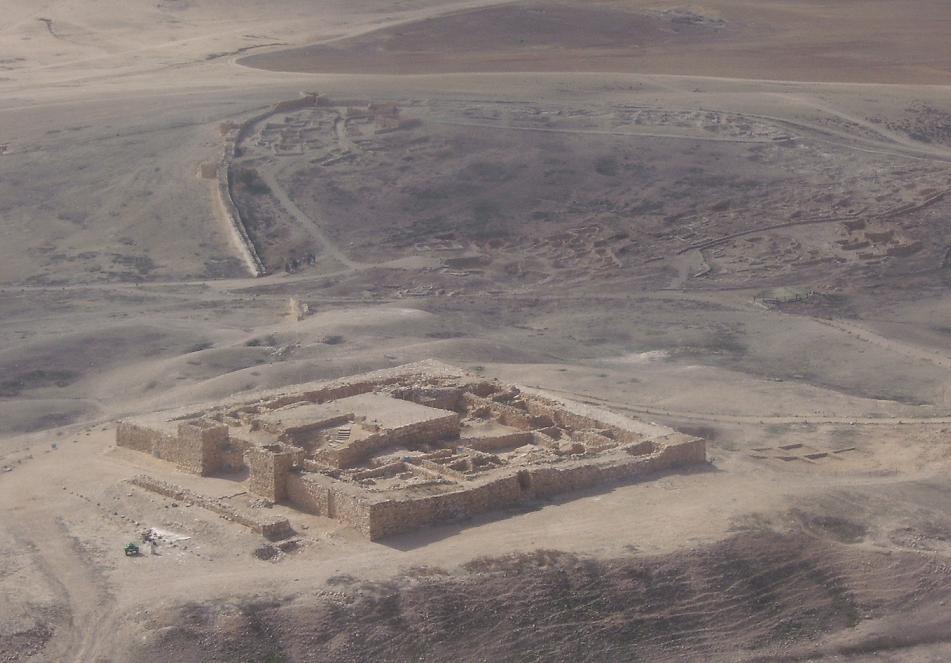
The site is now erroneously called Tel Arad because the heathens have been confounded by YA’OH.
[27] And he will make strong a covenant with many one week. The identity of the “he,” the subject of the causative verb wa-hagbayr (והגביר), “and he will make strong,” is supplied in verse 27. He is a man who will put a stop to sacrifices at the temple, which implies that the people of Ya’oh-shar-al have returned to their promised land and have rebuilt the altar of sacrifice prior to this man’s desecration. The final “one week,” i.e. the 70th week, begins with this man making a strong covenant with many, and since we know this man is Gog from the north, we know the covenant being spoken of here is the confederacy of the many nations that Gog assembles according to Ya’oh-khazak-al (Ezekiel) 38. His covenant will include the nations of Magog, Mashach, Thobal, Paras, Chosh, Pot, Gamar, and Thagaramah (38:2, 5, 6).
and in the middle of the week will he cause to cease the sacrifice and the offering. The redeemed of Ya’oh-shar-al return to their land and strengthen the covenant of YA’OH in the land by rebuilding the altar and the temple, while at the same time Gog will be busy forming a covenant with many heathen nations in order to put a stop to what the people of Ya’oh-shar-al are doing. He will use this allied coalition in order to invade our land in the middle of the week which is three and a half years into the week. None of this can happen until after the tribes of Ya’oh-shar-al have exited the wilderness and have reclaimed the promised land from out of the heathen hands that occupy it now (Ya’oh-khazak-al 38:8), and thus we learn that the GAP will end and the 70th week will begin when Ya’oh-shar-al is back in its land again.
and upon the wing the abominations of desolations, even until the end, and that which is determined will be poured upon the one who desolates. The abomination of desolations is not something that comes into existence during the 70th week. It is something that has been here for many centuries already. It is the religion of Christianity, the gospel of Jesus Christ, which calls for the worship of a man as the Creator of heaven and earth who died on a cross to atone for sins. This is an abomination, and Gog, when he puts a stop to our sacrifices at our temple, will introduce this “god of churches” abomination of desolation upon one of the four wings of our holy place (either the north wing, or the south wing, or the west wing, or the east wing). This act of desecration on Gog’s part will trigger the greatest armed conflict in human history, but it will be short lived. The desolator will be destroyed by the end of the week, three and a half years after he set up the abomination of desolation. He will be driven into a barren and desolate land and meet his end at a glorious set apart mountain situated between two seas (Ya’oh-al [Joel] 2:20; Danay’al 11:45).

We do not have much time left.
Everything I have said above about the shAbai’aym shabai’aym (‘weeks seventy’) is invalid unless they are being said by a genuine prophet raised up at “the time of the end”. Anyone claiming to be able to teach and to explain the shAbai’aym shabai’aym but who is not a prophet of YA’OH proclaiming His correct name and calling the people of Ya’oh-shar-al to return to keep the whole covenant given by the hand of Mashah, every word of it, is misleading you.
His name is YA’OH
Always has been. Always will be.
#EXODUS2023
1.15.7252 (April 5, 2023)
